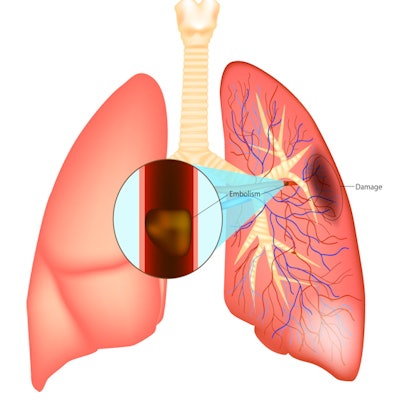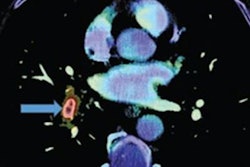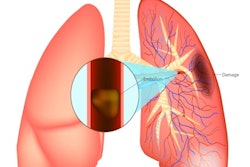
High-risk CT pulmonary embolism (CTPE) findings on emergency department assessment for acute pulmonary embolism (PE) don't necessarily predict short-term outcomes, researchers have found.
These types of CTPE findings tend to translate into hospital admittance, but outpatient care may be a viable option, wrote a team led by Dr. Connor O'Hare of the University of Michigan in Ann Arbor. The study results were published May 31 in JAMA Network Open.
"[Our results] indicate that CTPE findings widely believed to confer high risk in the setting of acute PE are associated with increased hospitalization and resource utilization in emergency department patients with low risk, but they were not associated with adverse clinical outcomes," the group noted.
More than 250,000 patients in the U.S. are diagnosed with acute PE each year, and most of these individuals are hospitalized, even though multiple society-based guidelines suggest clinicians consider outpatient treatment for those with low-risk stratification scores, the authors wrote.
"In reality, little evidence is available regarding the prognostic value of CTPE imaging in patients with acute PE and low risk stratification scores," the group explained. "[Yet] there remains concern among many emergency medicine clinicians that certain CTPE findings confer higher risk of adverse outcome, irrespective of risk stratification score."
O'Hare's group sought to assess the association of CTPE findings with patient outcomes and treatment for individuals presenting in the emergency department with acute, low-risk PE. The team conducted a study that included data from a registry of all acute pulmonary embolisms diagnosed in an adult emergency department between October 2016 and December 2019; the patient cohort consisted of 817 individuals.
The authors divided patients into high- and low-risk groups based on the PE Severity Index tool, further dividing the low-risk group into those with troubling CTPE findings and those without. The study's primary outcome was all-cause mortality at seven and 30 days, while secondary outcomes included hospitalization, length of stay, need for intensive care, use of echocardiography and/or point-of-care ultrasound, and activation of a PE response team.
Patient outcomes were similar for both groups of low-risk patients, as indicated in the table below.
| Frequency of care elements and patient outcomes in those with low-risk PE by presence of concerning factors | |||
| Factor | Without concerning CTPE findings | With concerning CTPE findings | p-value |
| 7-day mortality | 0 | 0 | -- |
| 30-day mortality | 2.2% | 0 | < 0.001 |
| Discharge from ED | 7.8% | 2% | 0.01 |
| Echocardiography | 27.2% | 57.6% | < 0.001 |
| Intensive care | 1.1% | 1.3% | 0.86 |
| Length of stay | 2.6 days | 2.3 days | 0.32 |
| Outpatient treatment | 7.8% | 2% | 0.01 |
| PE team support | 6.1% | 22.5% | < 0.001 |
The fact that patients with worrying CTPE findings didn't have longer length of hospital stay, intensive care admission, or higher seven- or 30-day mortality rates than those without suggest that outpatient care could be a viable way to track this population, according to the authors.
"Our findings suggest not only that outpatient management may be considered for these patients, but that concerning CTPE findings represent an important barrier to discharge," they wrote. "Compelling evidence, including the results of the current study, will likely need to be paired with effective implementation strategies to overcome their perceived risk."





















